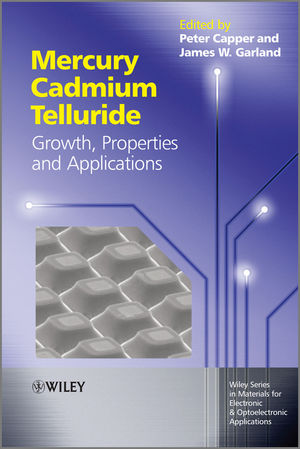Mercury Cadmium Telluride: Growth, Properties and ApplicationsISBN: 978-0-470-69706-1
Hardcover
590 pages
November 2010
 |
||||||
Series Preface
Preface
Foreword
List of Contributors
Part One - Growth
1 Bulk Growth of Mercury Cadmium Telluride (MCT)
P. Capper
1.1 Introduction
1.2 Phase Equilibria
1.3 Crystal Pr operties of MCT epilayers grown by MBE
7.8 Conclusions
References
Part Two - Properties
8 Mechanical and Thermal Properties
M. Martyniuk, J.M. Dell and L. Faraone
8.1 Density of MCT
8.2 Lattice Parameter of MCT
8.3 Coefficient of Thermal Expansion for MCT
8.4 Elastic Parameters of MCT
8.5 Hardness and deformation characteristics of HgCdTe
8.6 Phase Diagrams of MCT
8.7 Viscosity of the MCT melt
8.8 Thermal properties of MCT
References
9 Optical Properties of MCT
J. Chu and Y. Chang
9.1 Introduction
9.2 Optical Constants and the Dielectric Function
9.3 Theory of Band-to-band Optical Transition
9.4 Near Band Gap Absorption
9.5 Analytic Expressions and Empirical Formulas for Intrinsic Absorption and Urbach Tail
9.6 Dispersion of the Refractive Index
9.7 Optical Constants and Related van Hover Singularities above the Energy Gap
9.8 Reflection Spectra and Dielectric Function
9.9 Multimode Model of Lattice Vibration
9.10 Phonon Absorption
9.11 Raman Scattering
9.12 Photoluminescence Spectroscopy
References
10 Diffusion in MCT
D. Shaw
10.1 Introduction
10.2 Self-Diffusion
10.3 Chemical Self-Diffusion
10.4 Compositional Interdiffusion
10.5 Impurity Diffusion
References
11 Defects in HgCdTe – Fundamental
M. A. Berding
11.1 Introduction
11.2 Ab Initio calculations
11.3 Prediction of Native Point Defect Densities in HgCdgTe
11.4 Future Challenges
References
12 Band Structure and Related Pr operties of HgCdTe
C. R. Becker and S. Krishnamurthy
12.1 Introduction
12.2 Parameters
12.3 Electronic Band Structure
12.4 Comparison with Experiment
Acknowledgments
References
13 Conductivity Type Conversion
P. Capper and D. Shaw
13.1 Introduction
13.2 Native Defects in Undoped MCT
13.3 Native Defects in Doped MCT
13.4 Defect Concentrations During Cool Down
13.5 Change of Conductivity Type
13.6 Dry Etching by Ion Beam Milling
13.7 Plasma Etching
13.8 Summary
References
14 Extrinsic Doping
D. Shaw and P. Capper
14.1 Introduction
14.2 Impurity Activity
14.3 Thermal Ionization Energies of Impurities
14.4 Segregation Properties of Impurities
14.5 Traps and Recombination Centers
14.6 Donor and Acceptor Doping in LWIR and MWIR MCT
14.7 Residual Defects
14.8 Conclusions
References
15 Structure and electrical characteristics of Metal/MCT interfaces
R. J. Westerhout, C. A. Musca, Richard H. Sewell, John M. Dell, and L. Faraone
15.1 Introduction
15.2 Reactive/intermediately reactive/nonreactive categories
15.3 Ultrareactive/reactive categories
15.4 Conclusion
15.5 Passivation of MCT
15.6 Conclusion
15.7 Contacts to MCT
15.7 Surface Effects on MCT
15.8 Surface Structure of CdTe and MCT
References
16 MCT Superlattices for VLWIR Detectors and Focal Plane Arrays
James Garland
16.1 Introduction
16.2 Why HgTe-Based Superlattices
16.3 Calculated Properties
16.4 Growth
16.5 Interdiffusion
16.6 Conclusions
Acknowledgements
References
17 Dry Plasma Pr ocessing of Mercury Cadmium Telluride and related II- VIs
Andrew Stolz
17.1 Introduction
17.2 Effects of Plasma Gases on MCT
17.3 Plasma Parameters
17.4 Characterization – Surfaces of Plasma Processed MCT
17.5 Manufacturing Issues and Solutions
17.6 Plasma Processes in Production of II-VI materials
17.7 Conclusions and Future Efforts
References
18 MCT Photoconductive Infrared Detectors
I. M. Baker
18.1 Introduction
18.2 Applications and Sensor Design
18.3 Photoconductive Detectors in MCT and Related Alloys
18.4 SPRITE Detectors
18.5 Conclusions on Photoconductive MCT Detectors
Ackowledgements
References
Part Three – Applications
19 HgCdTe Photovoltaic Infrared Detectors
I. M. Baker
19.1 Introduction
19.2 Advantages of the Photovoltaic Device in MCT
19.3 Applications
19.4 Fundamentals of MCT Photodiodes
19.5 Theoretical Foundations for MCT Array Technology
19.6 Manufacturing Technology for MCT Arrays
19.7 Towards “GEN III” Detectors
19.8 Conclusions and Future Trends for Photovoltaic NCT Arrays
References
20 Nonequilibrium, dual-band and emission devices
C. Jones and N. Gordon
20.1 Introduction
20.2 Nonequilibrium Devices
20.3 Dual-Band Devices
20.4 Emission devices
20.5 Conclusions
References
21 HgCdTe Electron Avalanche Photodiodes (EAPDs)
I. M. Baker and M. Kinch
21.1 Introduction and Applications
21.2 The Avalanche Multiplication Effect
21.3 Physics of MCT EAPDs
21.4 Technology of MCT EAPDs
21.5 Reported Performance of Arrays of MCT EAPDs
21.6 Laser-gated Imaging as a Practical Example of MCT EAPDs
21.7 Conclusions and Future Developments
References
22 Room-temperature IR photodetectors
Jozef Piotrowski and Adam Piotrowski
22.1 Introduction
22.2 Performance of Room-Temperature Infrared Photodetectors
22.3 MCT as a Material for Room-Temperature Photodetectors
22.4 Photoconductive Devices
22.5 Photoelectromagnetic, Magnetoconcentration and Dember IR Detectors
22.6 Photodiodes
22.7 Conclusions
References
Index



